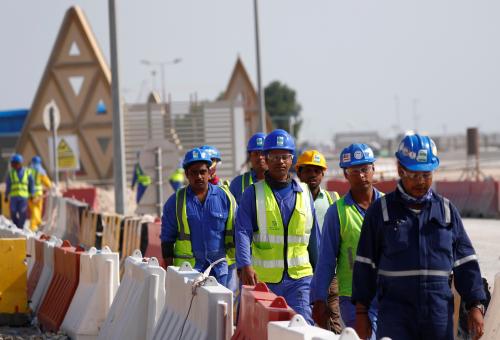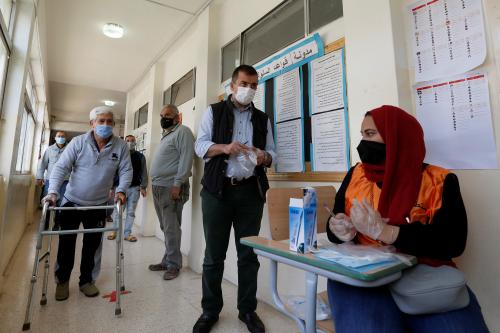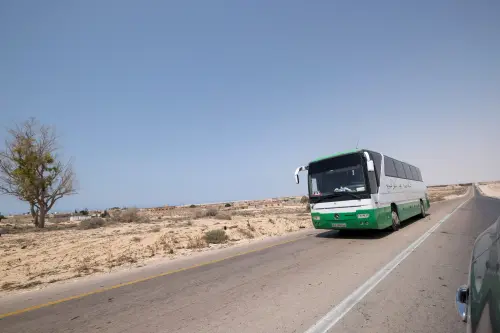Content from the Brookings Doha Center is now archived. In September 2021, after 14 years of impactful partnership, Brookings and the Brookings Doha Center announced that they were ending their affiliation. The Brookings Doha Center is now the Middle East Council on Global Affairs, a separate public policy institution based in Qatar.
While we may refer to the Syrian crisis as a uniform sticking point in Turkey–U.S. relations, in reality the nature of Turkey’s grievances vis-à-vis the United States has changed during the course of the Syrian crisis, writes Galip Dalay. This article originally appeared on the German Marshall Fund website.
No single issue has ever poisoned Turkey–U.S. relations as much as the Syrian imbroglio. Aside from shaping the Turkish domestic political context significantly, the Syrian crisis has also impacted Turkey’s foreign policy and its alliance structure. Turkey’s geopolitical identity, its longstanding alliance with the United States, and its place within NATO are now coming into question. Turkey’s increasing cooperation with Russia, as well as with Iran, is seen as incompatible with its NATO identity, and Western-centric geopolitical and security identity in general.
While we may refer to the Syrian crisis as a uniform sticking point in Turkey–U.S. relations, in reality the nature of Turkey’s grievances vis-à-vis the United States has changed during the course of the Syrian crisis. At the outset of this crisis, the focus was exclusively on the removal of the Assad regime, and Turkey’s major complaint was related to the Obama administration’s perceived lack of determination in toppling the Assad regime. This continued until late 2014 to early 2015. At the same time, the United States chastised Turkey for its lax approach to the passage of extremist militants through its borders into Syria. By then, the United States had already prioritized the war on terror over regime change in Damascus. But the United States was not the only actor who recalibrated its Syrian policy. Turkey’s Syria policy was undergoing a major transformation, increasingly moving away from its Assad-regime centric Syria policy to one centered on the Democratic Union Party (PYD) and People’s Protection Units (YPG). Given the link between the PYD and the Kurdistan Workers’ Party (PKK), Turkey increasingly adopted a policy of counterinsurgency in Syria. Both Turkey and the United States engaged local allies or proxies to achieve their goals, but they regarded each other’s local allies with suspicion, if not as outright terrorists, generating significant tensions in the bilateral relationship.
As the U.S. war on the self-proclaimed Islamic State has neared an end, Turkey’s concern over the increasing prominence of the PYD–YPG’s role in northern Syria has reached a climax. These concerns have motivated Turkey to move away from being largely a bystander to developments in northwestern Syria to becoming an active participant. Turkey’s road to becoming an active player in northwestern Syria passed through Moscow. Turkey swiftly mended ties with Moscow, which broke down after Turkey shot down a Russian jet in November 2015, from the second half of 2016 onward. Once relations were patched up with Russia, Turkey then embarked on its policy of direct and indirect confrontation with the PYD–YPG. It implemented this policy in several phases.
First, through the Euphrates Shield Operation of 2016 and 2017, Turkey carved out an enclave run by itself and allied opposition groups between the regions of Manbij and Afrin, which were then administered by the Syrian Kurdish PYD–YPG. This operation ensured that the PYD run areas in northern Syria remained fragmented. Second, with Turkey setting up de-escalation posts in Northern Idlib (As a result of Turkey–Russia–Iran’s deal for the creation of de-escalation zones within the framework of the Astana process), which lies to the West of Afrin region, Turkey effectively halted any westward expansion by the PYD toward the Mediterranean. This operation served another of Turkey’s goals in Syria: keeping the Kurdish enclave landlocked. Third, with the Afrin operation and the capture of the town, Turkey embarked on the policy of rolling back PYD-led Syrian Kurdish territorial gains elsewhere, particularly to the west of the Euphrates.
At this stage, Turkey appears to be close to fulfilling what it has advocated for some time: pushing the PYD to the east of the Euphrates. Turkey’s military victory in the Kurdish-dominated Afrin province has brought it a step closer to this goal. Besides Tal Rifat, the only remaining area that has a YPG presence west of the Euphrates is the U.S.-controlled Manbij. Nevertheless, finding a modus vivendi between Turkey and the United States on Manbij is unlikely to be detached from finding some form of mutual understanding on the areas east of the Euphrates. Therefore, Manbij will be part of a larger settlement which is likely to go beyond bilateral Turkey–U.S. relations. The United States’ long-anticipated anti-Iranian policy and its newly reinvigorated anti-Russia policy is likely to form part of short, medium, and long-term discussions between Turkey and the United States on Manbij.
Guiding principles
While formulating their policies in Syria during the next phase, Turkey and the United States should pay attention to three core principles.
Demographic legitimacy: As in many civil war contexts, Syria has experienced a significant level of forced demographic changes. Such demographic engineering makes the task of post-civil war reconciliation even harder to achieve. The United States controls a significant chunk of territory in Syria. Likewise, Turkey’s zone of influence or control is forming in the northwestern part of Syria. Both actors should make sure that in the administrative and security structures of their respective zones of influence the principle of demographic legitimacy is observed. These structures should genuinely reflect the demographic compositions of these areas.
Governance legitimacy: The quality and capacity of governance is a key legitimacy enhancing factor in civil war contexts. Both Turkey and the United States should devise strategies that will enhance and increase the quality of governance, including but not limited to the security sector, in their respective areas.
The Syrianization of governance and administration: In order for the United States and Turkey not to be perceived as long-running occupying forces and for their local allies to transition from being armed insurgencies to capable governing bodies, they need to put in place a gradual policy of transferring the roles and responsibilities of governance to Syrian actors in earnest.
Short-Term Perspectives
Setting these principles aside for the time being, the predominantly Arab demographics of Manbij coupled with previous U.S. promises to Turkey that the YPG would withdraw to the east of the Euphrates once ISIS is pushed out of the area have given rise to a formula that many have advocated, which is a joint administration or supervision of the administration of the city by Turkish and American forces. But such a formula is unlikely to be implemented on its own without some form of understanding on the territory to the east of the Euphrates. At this stage, a dilution strategy aimed at reducing the YPG and PYD’s dominance over regional security and administrative structures appears to be a compromise formula. In this respect, both the creation of the Syrian Democratic Forces and the recently announced Syria Future Party are steps in the right direction, though they are insufficient in themselves. The growing Arab components of the security and administrative structures of the U.S.-protected areas east of the Euphrates are crucial for the sustainability and demographic legitimacy of these structures. Likewise, Turkey should ensure that any administrative structures or local administration that is put in place in the Afrin province reflects the Kurdish-majority nature of the province. In fact, given the increased prominence that these identities have received during the Syrian civil war, demographic legitimacy should be one of the guiding principles for any security and administrative structures that Turkey and the United States put in place on either side of the Euphrates.
Medium to Long-Term Perspectives
Though these two steps are important to overcome the burgeoning crisis in Turkey–U.S. relations, they are insufficient as a model or vision for Syria. The United States and Turkey should treat any breakthrough on Manbij or any other issues of concern as serving as confidence-building measures between both sides paving the way for deeper engagement in Syria. Here the United States should appreciate the Turkish role in filling a void to the west of the Euphrates, which could have potentially have been filled by Russia, Iran, and/or the regime.
On the other hand, Turkey should appreciate the fact that its partnership with the United States is likely to prove more beneficial for the Syrian opposition than its semi-alliance with Russia, which is determined to cut the Syrian opposition down to size as much as possible. Likewise, though the U.S. partnership with the YPG has caused much concern in Ankara, a hasty U.S. departure from Syria would re-escalate the situation, likely prompting a fierce scramble between Turkey, Iran, the regime, and Russia for the land east of the Euphrates.
In this respect, once a deal on Manbij is reached, Turkey and the United States should work with each other on a scheme for northern Syria in general. Turkey should facilitate access for the United States (not necessarily militarily) to the west of the Euphrates and the United States should do likewise for Turkey for the east of the Euphrates.
In this period, the initial goal should be to create as much harmonization as possible when it comes to the administrative and security structures of the Turkey and U.S.-controlled zones. From the school curriculum to the legal system to the police force, the ultimate goal of this harmonization should be the integration of both regions. In this regard, a joint administration of Manbij could serve as a testing ground or role model for the administration of this larger integrated area.
One of the building blocks of such a jointly-administrated area could be the emergence of cross-communal political parties operating both in Turkish and U.S. controlled areas. Both Turkey and the United States should encourage the development of such parties and a regional parliament, which can play a significant role in political integration. Once this Turkey–U.S. understanding and cooperation is reached in Syria, both parties then can and should engage Europeans to initiate stabilization and reconstruction efforts in these integrated regions.
This gradual integration of the Turkey–U.S. zones of control will reduce Turkey’s dependency on Russia. Likewise, this area will provide the opportunity for opposition or non-regime Syrian groups to undertake democratic experiments or different modes of governance to those of the regime in approximately one third of the Syrian territory. This in return may undermine the recently popular “the regime is winning and the opposition losing” argument down the road.
The Brookings Institution is committed to quality, independence, and impact.
We are supported by a diverse array of funders. In line with our values and policies, each Brookings publication represents the sole views of its author(s).




Commentary
Op-edBreaking the Turkey–U.S. deadlock in Syria
Monday, April 16, 2018